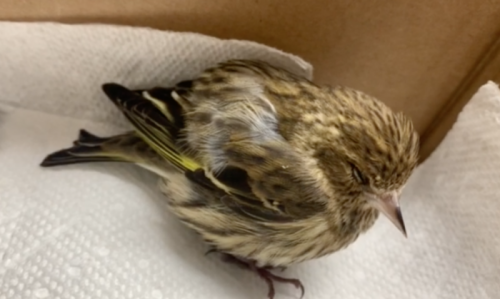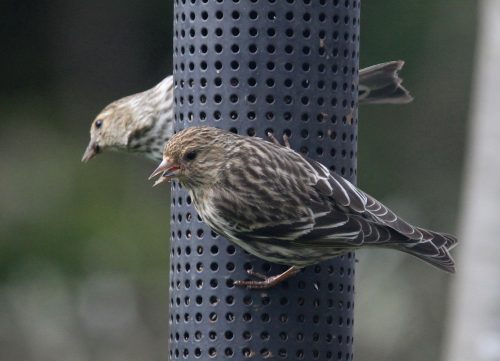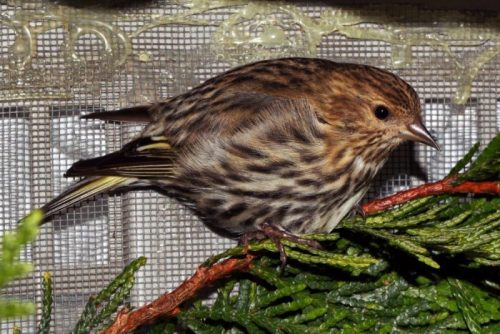Support Us
Since 1979 more than 140,000 animals have been treated by Wildlife Rescue.
Thanks to the support of individuals like you, Wildlife Rescue can provide a lifeline for animals in distress.
An outbreak of Salmonella in wild bird populations is being seen across the province. Wildlife Rescue is currently admitting record-breaking numbers of Pine Siskins showing symptoms of Salmonella infection. Here are some commonly asked questions regarding this outbreak answered! You can help wildlife in distress by educating yourself on this important subject and sharing with family and friends.
Look for the following symptoms and behaviour:
If you observe any of the indications above please attempt to contain the sick bird(s) if they are approachable.
Place a small towel or cloth gently over the bird, pick it up, and place it into a ventilated and covered cardboard box. Place the contained bird in a location that is warm, dark and quiet and away from people and pets. Thoroughly wash your hands with warm, soapy water and contact our Support Centre for assistance. We will go through our Covid screening questions with you and then ask you to bring the bird to our hospital.

Watch video of a Pine Siskin showing signs of Salmonella infection [YouTube Link].
Our hospital staff do a full assessment and decide on an appropriate course of action from their findings.
Pine Siskins are highly susceptible to salmonella, likely due to their natural history, behaviour, and anatomy.
If you find a Pine siskin exhibiting the symptoms of salmonella, it is best to bring that bird to the nearest Wildlife Rehabilitation Centre for assessment.
If the bird is confirmed to have salmonella it will reduce the spread of the disease in your area. This is because the sick or dead birds have a high likelihood of being picked up by predators, cats and unsuspecting humans increasing the risk of transmission of salmonella to them. The sick birds will continue to eat food, produce waste, and contaminate the other animals. Therefore, bringing the animal to a Rehabilitation Centre will stop this bird from transmitting the disease.
You can dispose of birds by deep burial to avoid scavenging, or you may double bag them and place them in the garbage. Placing them in your household green bin is not recommended at this time.
Salmonellosis is transmitted via the fecal-oral route i.e., the accidental ingestion of Salmonella bacteria in contaminated food or water, and/or exposure to contaminated equipment (e.g. bird feeders).
If there is an outbreak of salmonella the best option is to remove the feeder and disperse the flock. If you choose to put up a feeder during a time when there is no known outbreak of diseases remember these points below:
Clean your bird feeders and bath two times a month with hot soapy water followed by a 3-minute soak in a 10% solution of domestic bleach (1-part sodium hypochlorite in 9 parts water) for disinfection. Feeders should be rinsed with clean cold water and dried thoroughly before refilling with fresh seed. Spilled seed should be swept up and disposed of daily.
Brushes and equipment used to clean bird feeders and baths should not be used for any other purpose. Keep them outside and away from food preparation areas.
Wear rubber or disposable gloves when cleaning feeders and thoroughly wash hands and forearms afterwards with soap and water, especially before eating and drinking. Avoid handling sick or dead birds directly.

During a known outbreak of salmonellosis, it’s important to remove bird feeders and baths for a minimum of two-weeks. Whenever possible, it’s best to leave them down until warmer spring weather to reduce the likelihood of transmission.
When birds are forced to look for wild food sources, they naturally break off into smaller flocks. During a year with a known outbreak of salmonella this is obviously favourable.
If you have an active flock of Siskins, Hummingbird feeders should also be removed and properly sanitized and left down until they leave. They can find another feeder, they can’t recover from Salmonella. If you do not see Pine Siskins, they can be left up with proper maintenance.
Proper maintenance is vital – hummingbirds can be impacted by a fungus if feeders aren’t properly maintained.
Siskins will occasionally use suet feeders. If you have an active flock of Siskins, suet feeders should also be removed and properly sanitized and left down until they leave. If you do not see Pine Siskins, they can be left up with proper maintenance.
A wildlife garden serves as a sustainable haven for surrounding wildlife. It is an ideal way to provide habitat and food, while minimizing the spread of disease, to wild birds.
Visit the Canadian Wildlife Federation’s website for tips on gardening for wildlife.
Salmonella can occur in all species of birds, mammals, reptiles and amphibians. We primarily see outbreaks in Pine Siskins in the Lower Mainland, but all animals are potentially at risk.
Important to note: Salmonella is a Zoonotic disease. It is transmissible to humans as well as our companion animals. It’s important to thoroughly wash your hands after contacting birds or anything birds may have touched.
Bring the bird into your local wildlife rehabilitator!
Wildlife Rescue Association of British Columbia
5216 Glencarin Drive, Burnaby, BC V5B 3C1
If you are not located in the Lower Mainland, please contact your nearest wildlife rehabilitator.

You can download a PDF of this FAQ here to print out and share.